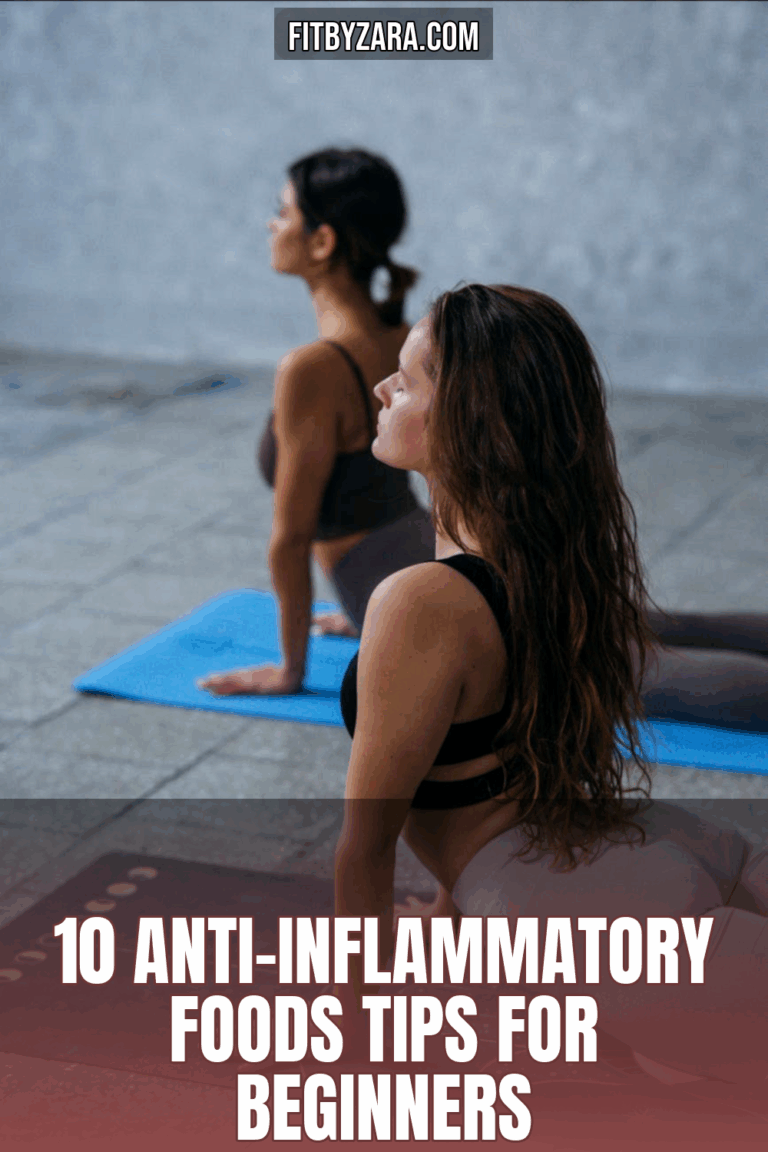Are you feeling a little sluggish, or maybe you’ve noticed some pesky aches and pains creeping in? As we step into our 30s and beyond, our bodies can start to feel the wear and tear of life. One of the best ways to combat this is through our diet. Anti-inflammatory foods can play a vital role in promoting overall wellness and vitality.

Hi, I’m Zara — fitness junkie, wellness nerd, and the voice behind FitByZara.com. This site is all about smart fitness and science-backed wellness tips for real women who want to feel their best.
In this post, I’ll share ten beginner-friendly tips on incorporating anti-inflammatory foods into your diet. Let’s get started on this delicious journey!
Understanding Inflammation
3-Day Energy & Metabolism Reset
Grab the 3-Day Energy & Metabolism Reset — a quick-start guide to feel lighter, more energized, and back in control.

Where should I send your free reset guide?
Before diving into the foods, let’s chat about inflammation. It’s a natural response from our body aimed at protecting us from harm, but chronic inflammation can lead to a variety of health issues. The good news? Your diet can help manage this!
What Are Anti-Inflammatory Foods?
Anti-inflammatory foods are those that help reduce inflammation in the body. They’re rich in antioxidants, fiber, vitamins, and minerals. Think colorful fruits, wholesome grains, lean proteins, and healthy fats.
10 Tips for Adding Anti-Inflammatory Foods to Your Diet
1. Start Your Day with a Smoothie
Why? Smoothies are a fantastic way to pack in nutrients and can be made in just a few minutes.
Try This:
- Base: Start with spinach or kale
- Fruit: Add berries (blueberries and strawberries are great!)
- Healthy Fats: Incorporate a tablespoon of flaxseeds or chia seeds
- Liquid: Use almond milk or coconut water for hydration
2. Embrace Colorful Fruits and Veggies
Why? Different colors typically mean different nutrients.
Checklist:
- Reds: Tomatoes, red peppers
- Oranges: Carrots, sweet potatoes
- Greens: Broccoli, spinach
- Purples: Eggplant, beets
Tip: Aim for a “rainbow” on your plate at every meal.
3. Snack on Nuts and Seeds
Why? Nuts and seeds are excellent sources of healthy fats, fiber, and protein.
Best Options:
- Almonds
- Walnuts
- Chia seeds
- Pumpkin seeds
Zara says: “Snack smart! A handful of nuts can be your best friend.”
4. Choose Whole Grains
Why? Whole grains are packed with fiber, which supports digestion and reduces inflammation.
What to Choose:
- Brown rice
- Quinoa
- Barley
- Oats
Tip: Swap out white bread for 100% whole grain options.
5. Incorporate Fatty Fish
Why? Fatty fish are rich in omega-3 fatty acids, which are known for their anti-inflammatory properties.
Top Picks:
- Salmon
- Mackerel
- Sardines
Tip: Aim for at least two servings a week.
6. Spice it Up
Why? Certain spices can add flavor *and* health benefits to your meals.
Spices to Consider:
- Turmeric: Contains curcumin, a powerful anti-inflammatory compound.
- Ginger: Great for digestion and has anti-inflammatory properties.
- Cinnamon: Can help regulate blood sugar levels.
Mini Checklist:
- Add turmeric to soups or smoothies
- Stir ginger into stir-fries or teas
- Sprinkle cinnamon on oatmeal or yogurt
7. Opt for Healthy Fats
Why? Healthy fats can help reduce inflammation and promote heart health.
Sources:
- Avocado
- Olive oil
- Coconut oil
Tip: Use olive oil as a salad dressing or for roasting veggies.
8. Hydrate Wisely
Why? Staying hydrated is essential for overall health and can help manage inflammation.
Best Choices:
- Water (of course!)
- Herbal teas (like green tea or ginger tea)
Tip: Add lemon or mint to your water for an extra flavor boost.
9. Limit Processed Foods
Why? Processed foods often contain additives, sugars, and unhealthy fats that can promote inflammation.
What to Avoid:
- Sugary snacks and drinks
- Fast food
- Packaged meals
Tip: Focus on whole, unprocessed foods whenever possible.
10. Practice Mindful Eating
Why? It’s not just about what you eat, but how you eat. Mindful eating can improve digestion and help you appreciate your food more.
Tips:
- Chew slowly and savor each bite.
- Turn off screens during meals.
- Pay attention to hunger and fullness cues.
Putting It All Together
Incorporating anti-inflammatory foods into your diet doesn’t have to be overwhelming. Start with a few tips that resonate with you and build from there. Here’s a quick recap of your action plan:
- Smoothie: Start your day with one!
- Colorful Plates: Include a rainbow of fruits and veggies.
- Healthy Snacks: Keep nuts and seeds on hand.
- Whole Grains: Choose them over refined options.
- Fatty Fish: Make it a weekly staple.
- Spices: Experiment with turmeric, ginger, and cinnamon.
- Fats: Opt for healthy fats like olive oil and avocado.
- Hydration: Drink plenty of water and herbal teas.
- Limit Processed Foods: Focus on whole foods.
- Mindful Eating: Enjoy your meals fully.
Final Thoughts
Adopting an anti-inflammatory diet is a fantastic way to nourish your body and boost your overall wellness. Remember, it’s about progress, not perfection. Start small, listen to your body, and enjoy the process.
With a little effort, you’ll be well on your way to feeling more vibrant and energized. Happy eating!
—
Thanks for joining me on this journey toward wellness! If you have any tips or favorite anti-inflammatory foods, drop them in the comments below. Let’s share the love and support each other on our paths to health! 🌿
HepatoBurn: Gentle Support for Steadier Days
When you’re stacking real habits—protein-forward meals, steps, and 7–9 hours of sleep—HepatoBurn is a simple add-on that supports the system behind energy, appetite, and metabolic rhythm.
Why Women 30+ Use It
- Pairs with an already-solid routine—no jitters, no crash.
- Easy to remember: 2 capsules with meals.
- Plays well with protein, walking, and strength training.
How to Use
- Timing: Breakfast & lunch are easy wins.
- Consistency: Use daily for a fair assessment.
- Stacks: Protein-first plates, post-meal walks, lights-down wind-down.
What It Isn’t
- Not a stimulant and not a magic fix.
- Best used alongside habits you’ll actually keep.
- Educational only—talk to your provider before new supplements.
Important: Educational only, not medical advice. Supplements don’t diagnose, treat, cure, or prevent diseases. Talk to your provider before changes to diet, exercise, or supplements.






















